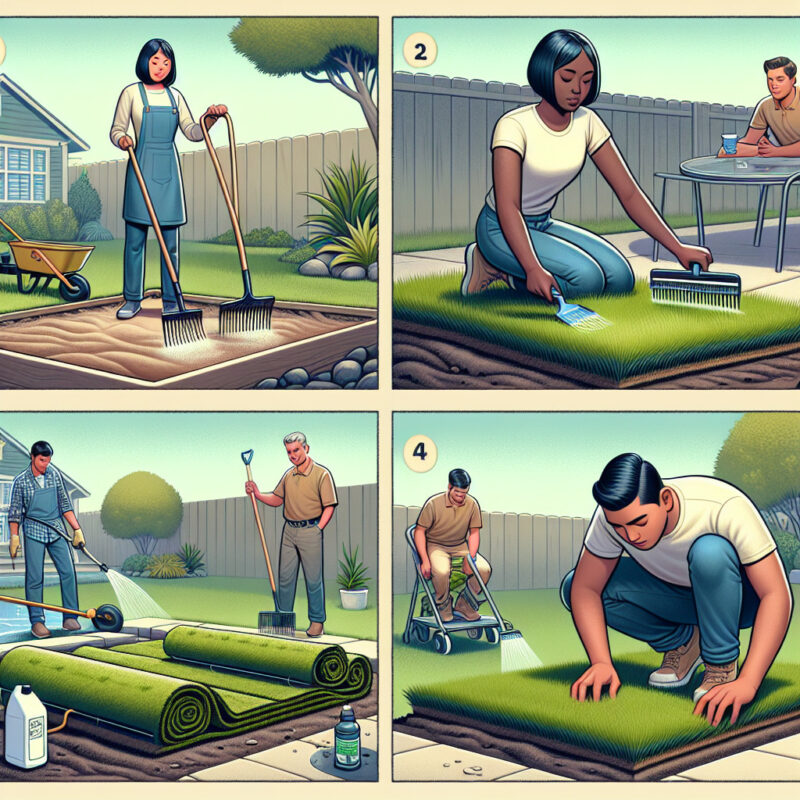Planting St. Augustine sod can be a rewarding and relatively simple process. Here are some useful tips to help guide you through the process. Firstly, it’s essential to prepare the soil before laying the sod. Clear the area of any debris, rocks, or weeds that may impede the growth of your new lawn. Using a garden rake, level the soil as much as possible, smoothing out any bumps or unevenness.
Next, you’ll want to measure the area where you plan to install the St. Augustine sod. This will help you determine the amount of sod you’ll need to purchase. It’s always recommended to order a little extra to account for any necessary adjustments or mistakes. Once you have your measurements and have obtained the sod, make sure it is delivered as close to your planned installation time as possible to avoid drying out.
To begin the installation, start at one corner of the area you are sodding. Unroll the sod carefully, ensuring it fits snugly against any existing edges or borders. Be sure to stagger the seams of each section, as this will provide a more even and visually pleasing result. It’s also important to avoid leaving any gaps or overlaps between the pieces of sod.
As you lay the sod, make sure it is pressed firmly into the soil. It should be in direct contact with the ground to establish proper root growth. You can use a lawn roller or simply walk across the sod to ensure good soil-to-sod contact. This step helps eliminate any air pockets and promotes a healthier lawn.
After the sod has been installed, watering is crucial for its successful establishment. Water the sod immediately after installation, providing a deep soak. This will help the roots reach down into the soil. For the first few weeks, you should water the sod daily, ensuring the soil stays consistently moist. As the roots become established, you can gradually reduce the frequency of watering.
It’s important to note that fertilizing your newly planted St. Augustine sod is a critical step in its development. Wait approximately six weeks after installation before applying a slow-release fertilizer specially formulated for St. Augustine grass. This will provide the necessary nutrients for healthy growth.
Lastly, regular maintenance is key to keeping your St. Augustine sod looking its best. Mow the lawn at a height of 3-4 inches to encourage deep root growth and prevent weed invasion. Remember to water deeply but infrequently, promoting strong roots and drought tolerance. And don’t forget periodic fertilization and weed control to maintain a lush and vibrant lawn.
With these tips, you’ll be well-equipped to successfully plant St. Augustine sod and enjoy a beautiful, green lawn for years to come. Happy planting!
Choosing the Right Area
When planting St Augustine sod, it is essential to select the right area for your lawn. Look for an area that receives at least six hours of sunlight per day, as St Augustine grass thrives in full sun. It is also important to ensure that the soil is well-drained to prevent waterlogged roots. Take note of any obstructions or tree roots that may hinder the growth of the sod.
Preparing the Soil
Before planting St Augustine sod, prepare the soil properly to create a favorable environment for the roots to establish. Start by removing any existing vegetation, rocks, or debris from the area. Once cleared, loosen the topsoil using a garden tiller or a rake to a depth of 4 to 6 inches. This will promote root penetration and encourage healthy growth.
Amending the Soil
St Augustine grass prefers slightly acidic soil with a pH range of 5.0 to 8.5. It is essential to have the soil tested to determine its pH level and nutrient content. Based on the test results, make any necessary amendments to adjust the pH or provide additional nutrients. This may involve adding lime to raise the pH or incorporating organic matter, such as compost or peat moss, for improved fertility and drainage.
Leveling and Smoothing the Surface
After preparing and amending the soil, ensure that the surface is leveled and smoothed. Use a rake or a lawn leveling tool to remove any remaining lumps, bumps, or inconsistencies. This step is crucial to provide a uniform surface for laying the St Augustine sod and to ensure proper water drainage.
Measuring and Ordering the Sod
Before ordering the St Augustine sod, accurately measure the area to determine the required amount. Calculate the square footage by multiplying the length and width of the designated area. It is recommended to add an extra 5-10% to account for any waste or cutting. Order the St Augustine sod from a reputable supplier, ensuring its freshness and quality.
Preparing for Sod Installation
On the day of sod delivery or pickup, make sure to install the sod as soon as possible to prevent drying out. Water the prepared soil lightly to moisten it, allowing for easier installation. Have all the necessary tools ready, including a sharp knife or sod cutter, a wheelbarrow, a garden hose, and a roller. Also, gather any helpers you may need for efficient sod installation.
Laying the Sod
Begin by laying the first row of St Augustine sod along a straight edge, such as a sidewalk or driveway. Place the sod tightly against the edge, ensuring there are no gaps. Lay subsequent rows in a staggered pattern, similar to how bricks are laid, to create a seamless and interlocking appearance. Press down on the sod to eliminate any air pockets and ensure good soil-to-sod contact.
Watering and Initial Care
To promote root establishment, water the newly installed St Augustine sod immediately after laying it. Apply enough water to reach the soil beneath the sod, ensuring it is adequately moist but not saturated. Water daily for the first two weeks, gradually reducing the frequency as the roots establish. Avoid heavy foot traffic or mowing until the sod is firmly rooted, usually after a few weeks.
Fertilizing and Maintenance
After the St Augustine sod has been established for about six to eight weeks, apply a balanced slow-release fertilizer to encourage healthy growth. Follow the recommended application rates on the fertilizer package. Additionally, regularly mow the grass to maintain a height of 2.5 to 4 inches, ensuring not to remove more than one-third of the grass blade at a time. Implement proper watering, weed control, and pest management practices to keep your St Augustine lawn thriving.
Pros of Planting St Augustine Sod
- Quick establishment: St Augustine sod has a rapid growth rate, allowing for the speedy establishment of a lush and green lawn.
- Drought tolerance: St Augustine grass has the advantage of being highly tolerant to drought conditions, making it a perfect choice for regions with limited water resources.
- Shade tolerance: This type of sod thrives in shady areas, making it suitable for yards with trees or buildings that cast shadows during parts of the day.
- Heat tolerance: St Augustine sod is known for its remarkable heat tolerance, enabling it to withstand hot summer temperatures and maintain its vibrant green color.
- Resilience to foot traffic: St Augustine grass is known for its ability to withstand heavy foot traffic, making it an ideal choice for lawns that will be frequently used for outdoor activities or have children and pets playing on them.
For instance, let’s say you live in a region with hot summers. Planting St Augustine sod would ensure that your lawn remains green and healthy even during scorching temperatures, whereas other grass types might struggle to survive.
In addition, imagine you have a house with a large tree providing shade to a significant portion of your yard. By planting St Augustine sod, you can still achieve a lush and green lawn in spite of the shade, unlike many other grass varieties that may struggle to grow in similar conditions.
Overall, planting St Augustine sod provides numerous advantages such as quick establishment, drought and shade tolerance, heat tolerance, and resilience to foot traffic, making it an excellent choice for those seeking a low-maintenance and vibrant lawn.
Cons of How To Plant St Augustine Sod:
- Requires a lot of water: One of the major disadvantages of planting St Augustine sod is its high water requirement. This type of grass needs frequent watering, especially during hot and dry periods. The excess water usage can be costly and can also contribute to environmental concerns such as water scarcity.
- Prone to thatch buildup: St Augustine sod is notorious for developing thatch, a layer of dead organic material that accumulates between the grass blades and the soil surface. Thatch buildup can prevent water and nutrients from reaching the roots, leading to weak and unhealthy turf. Regular dethatching is necessary to control and prevent this issue.
- Susceptible to diseases and pests: St Augustine sod is relatively more susceptible to various diseases and pests compared to other types of grass. Common problems include brown patch, gray leaf spot, chinch bugs, and sod webworms. These issues can result in unsightly patches, thinning grass, and the need for frequent treatments and maintenance.
- Requires regular fertilization: St Augustine sod has a high nitrogen requirement and needs regular fertilization to maintain its lush green appearance. Failure to provide adequate nutrients can result in yellowing or overall decline of the grass. The need for frequent fertilization adds to the overall maintenance and ongoing costs of planting St Augustine sod.
- Not suitable for heavy foot traffic: Although St Augustine sod is known for its dense and lush growth, it is not very tolerant of heavy foot traffic. Areas frequently used for sports or high human activity may experience thinning and wear, requiring frequent repairs or replacement of the sod.
Case Study 1: Josh planted St Augustine sod in his backyard. Despite following the recommended watering schedule, he noticed a significant increase in his water bills. The continuous need for watering to keep the grass healthy became financially burdensome for him.
Case Study 2: Mary planted St Augustine sod in her front yard. After a few months, she noticed brown patches and irregular growth patterns. Upon inspection, she discovered the presence of chinch bugs, a common pest that targets St Augustine grass. Controlling the infestation required immediate treatment and ongoing pest management.
Case Study 3: David installed St Augustine sod in an area that received moderate foot traffic from his kids and pets. Over time, the sod started to thin out and develop bare patches due to the constant wear and tear. This forced David to seek alternative grass types or invest in frequent sod replacement to maintain a visually appealing lawn.

